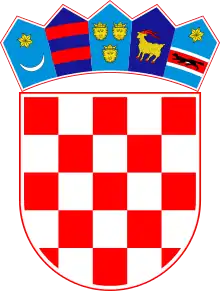Croatia–United States relations
Croatia–United States relations refer to the bilateral relationship between Croatia and the United States. Diplomatic relations among two countries were established on April 7, 1992 following Croatia's independence from SFR Yugoslavia. The mutual relations continue to be cordial, friendly, and very close.
 | |
Croatia |
United States |
|---|---|
| Diplomatic mission | |
| Croatian Embassy, Washington D.C. | United States Embassy in Zagreb |
| Envoy | |
| Pjer Šimunović | William Robert Kohorst |
Croatia has an embassy in Washington, D.C., general consulates in Chicago, Los Angeles, New York City, and consulates in Anchorage, Kansas City metropolitan area, Pittsburgh, Seattle and Houston. The US has an embassy in Zagreb.[1]
American engagement in Croatia is aimed at fostering a democratic, secure, and market-oriented society that will be a strong US partner in Euro-Atlantic institutions. Bilateral relations between the two countries are described as very strong.[2][3]
Croatian diaspora in the US is one of the largest in the world with an estimate of more than 1.2 million members. Most of the Croats live in Chicago (~150,000), New York City, New Jersey and Connecticut (~80,000), St. Louis (~40,000), San Pedro (~35,000), Detroit (~7,000) and San Jose (~5,000). The National Federation of Croatian Americans is the main organization that brings together Croats in the US.[4]
Both countries are members of UN, NATO, Euro-Atlantic Partnership Council, Organization for Security and Co-operation in Europe, International Monetary Fund, World Bank and World Trade Organization. In addition, Croatia is an observer to the Organization of American States.
Embassy
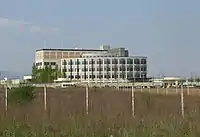
The official presence of the US in Croatia began with the establishment of the US Consulate in Zagreb on May 9, 1946. The consulate became a consulate general on August 1, 1958.[5]
Upon the dissolution of Yugoslavia, the U.S. recognised Croatia as an independent state on April 7, 1992. The U.S. Consulate General in Zagreb gained the status of an embassy on August 25, 1992. The first U.S. ambassador to Croatia was Peter W. Galbraith who served on this position from 1993 to 1998.[6]
The U.S. embassy in Croatia is located in Zagreb, southwest of Buzin. This 8000 m2 compound was opened on June 2, 2003. According to an article based on the WikiLeaks documents published in a British newspaper The Independent in 2013, the embassy, namely its fifth floor, is used as a regional base of CIA and NSA.[7]
The U.S. embassy in Zagreb is a charter member of the League of Green Embassies and a founding member of the Zagreb Green Building Council. According to this, embassy support recycling, energy and water use reduction programs. The embassy also sponsors American Corners at libraries in Osijek, Rijeka, Zadar, and Zagreb.[5][8]
Since November 2017, the U.S. ambassador to Croatia is William Robert Kohorst.
History
Background
The Republic of Ragusa, a merchant republic centered at the Croatian city of Dubrovnik, was one of the first foreign countries to de iure recognize independence of the United States. Sources differ on when the recognition took place: some travel guides and tourist portals claim that Ragusa was the very first country to recognize the United States as early as 1776,[9][10] a document whose copy was presented to U.S. Vice President Dick Cheney in 2006 reportedly puts the date at 1783,[11] while the Council of American Ambassadors claims that the recognition was extended during the term of the second President of the United States, John Adams, thus between 1797 and 1801.[12]
Visits of U.S. Presidents to Croatia

The first U.S. President to visit Croatia was Richard Nixon, who came to Zagreb on 2 October 1970 during his state visit to Yugoslavia. The choice to visit Zagreb during political and cultural developments in Socialist Republic of Croatia that would culminate in the Croatian Spring, along with Nixon's praise for the "spirit of Croatia" and his exclamation "Long live Croatia! Long live Yugoslavia!", has been interpreted as a statement of support for Croatian identity and greater autonomy within the federal framework of Yugoslavia.[13][14][15]
The first U.S. president to visit independent Croatia was Bill Clinton on 13 January 1996. Clinton spent a few hours on the Zagreb Airport while returning from visiting IFOR troops in Tuzla, Bosnia and Herzegovina. During the brief visit, Clinton gave a speech in front of a crowd waving Croatian and American flags, then met with Croatian President Franjo Tuđman.[16][17]
On 4 April 2008, U.S. President George W. Bush arrived in Zagreb on an official 2-day state visit. The visit immediately followed the 2008 Bucharest summit of NATO countries where Croatia and Albania received invitations to join the alliance. Bush met with President of Croatia Stipe Mesić and Prime Minister Ivo Sanader, and gave a speech in St. Mark's Square in downtown Zagreb. Peaceful rallies were held during the visit to protest U.S. foreign policy and impending Croatian NATO membership.[17][18]
Visit of Hillary Clinton to Croatia (2012)
US Secretary of State Hillary Clinton visited Croatia on October 30, 2012. During her visit she met with many Croatian officials including President Ivo Josipović, Prime Minister Zoran Milanović and Foreign Minister Vesna Pusić. Main topics of discussions were Croatian role in NATO and the Croatian accession to the European Union as well as economic relations between US and Croatia. Secretary Clinton called Croatia "a leader in Southeast Europe" that had well educated workforce, established infrastructure, great geopolitical location, adding that it was promising destination but that there was still a necessity for additional reforms, increase of transparency, elimination of bureaucratic barriers, as well as the privatization of the companies that are still owned by the state.[19][20][21]
Visit of Joe Biden to Croatia (2015)
On November 25, 2015 US Vice President Joe Biden visited Croatia as a special guest of the Brdo-Brijuni Process Leaders' Summit that brings together heads of state from the countries of former Yugoslavia and Albania as well as special guests. The summit was co-chaired by Croatian President Kolinda Grabar-Kitarović and Slovenian President Borut Pahor. Discussed topics on the plenary session were integration of south-east Europe into Euro-Atlantic processes, migrant crisis, security challenges and the fight against terrorism, conflicts in the Middle East and Ukraine, as well as energy. Vice President Biden stated: "For the United States and for me personally, but I am speaking on behalf of the President Obama, this region has been of extreme interest for the last 25 years." In addition, Biden praised Brdo-Brijuni initiative as "a good job as it has managed to bring together heads of state for talks for the past five years". Vice President Biden also met with the Croatian Prime Minister Zoran Milanović and Foreign Minister Vesna Pusić with whom he talked about situation in the Middle East, especially about the war in Syria, migrant crisis and the security situation in the world after 2015 Paris terrorist attacks.[22][23][24]
Visit of Mike Pompeo to Croatia (2020)
On October 2, 2020, U.S. secretary of state Mike Pompeo visited Dubrovnik, where he had a meeting with Croatia's prime minister Andrej Plenković and other Croatian government officials. Following the meeting, the Croatian foreign minister, Gordan Grlić-Radman, said that Croatia had signed no document whereby it would undertake to refrain from co-operating with China on the issues of security with a view to 5G.[25][26] Pompeo's visit was foreshadowed by statements made by Croatia's president Zoran Milanović, who harshly criticised the U.S. top leaders, saying, among other things, that Donald Trump had ruined the international reputation of the United States.[27] Following Pompeo′s visit, Milanović, who had not participated in hosting the secretary of state, spoke against the Three Seas Initiative, saying it was the Obama administration′s initiative that was potentially harmful for Croatia as it was aimed at isolating Russia as well as Germany, an endeavour he said Croatia ought not to participate in.[28][29]
Military cooperation

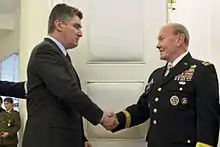
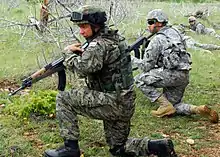

As of January 2020, the U.S. State Department′s web site alleged that the U.S. Department of Defense had "a robust military-to-military relationship with Croatia" with the U.S. providing military assistance to Croatia in the form of training, equipment, equipment loans, and education in U.S. military schools.[30]
In April 2014, Croatia took delivery of 30 U.S. MRAP vehicles out of the 212 MRAP vehicles that the U.S. government had decided on donating to Croatia.[31]
The U.S. and Croatia work together in these 11 military programs, funds and initiatives:[32]
- Foreign Military Financing - FMF
-Croatia received from this program from 2000 until FMF's suspension in 2003 $18.5 million. Once FMF was launched again in 2008 Croatia received addition $14.5 million. Croatia spent this money mostly on purchase of communication systems, simulators and equipment for night surveillance.
- Foreign Military Sales - FMS
-Croatia bought $4.2 billion worth products from this program; flight equipment, communications devices, night vision equipment and software's for Croatia's Main Simulation Centre.
- Global Peacekeeping Operations Initiative - GPOI
-Around $5.1 million that Croatia received from this Program was spent for equipping two classrooms for foreign language learning in Knin and Našice, buying navigation equipment and equipment for the night flying, as well as for training helicopter pilots for the night flights.
- Program - article 1206 - Train and Equip
-From this program Croatia received from 2010 to 2014 $31 million. With this money Croatia bought HMMWV vehicles for training, communication and navigation equipment, equipment for night surveillance, labeling and identification of army vehicles and MILES 2000 adjustment system for Croatian VHS-D rifle. In 2015, Croatia received $11 million for purchasing communications equipment and training its special forces.
- The program - article 1202 - Enhanced ACSA (Acquisition and Cross Servicing Agreements)
-Through this program US lends its allies that are participating in missions in Afghanistan and Iraq military equipment for a period of approximately one year. Croatia received through this program 50 HMMWV and 12 MRAP vehicles [which Croatia kept as a gift after the end of missions in Afghanistan and Iraq], ballistic missiles and systems for command, control and communication (Blue Force Tracking).
- Excess Defense Articles - EDA
-Through this program Croatia bought 212 used MRAP vehicles: 162 M-ATV, 30 Navistar MaxxPro Plus, and 20 medical vehicles MRAP HAGA.
- Coalition Support Funds - CSF
-Through this program Croatia received from the US partial refund of its money invested in ISAF missions in which Croatia participated from 2011 until 2013. $16.9 million were refunded to Croatia. This money will be used for improving maritime radar Enhanced Peregrine.
-Croatia at first participated in this program from 1995 to 2003 when it got banned from participating due to some diplomatic disagreements between US and Croatia. On October 2, 2006 George W. Bush with his decree abolished the restraining Croatia from participating in IMET program "because of the Croatian importance for US national interests". Croatia through the IMET program implemented over 600 activities with costs estimated at about $9 million.
- Cooperative Logistic Support Supply Arrangement - CLSS
-Croatia signed this agreement and become part of the US logistics data base. This agreement enables Croatia to independently buy spare parts for its HMMWV vehicles which wouldn't be possible without this agreement because the only authorized buyer of spare parts for HMMWV is the US and anyone that wants to buy any spare parts has to ask US for permission.
- Man-portable air-defense system - MANPADS
-US donated to Croatia cca. $2 million through this program so Croatia could destroy some of its anti-aircraft systems that are dysfunctional.
- The program of demining and the destruction of surplus munitions
-US donated to Croatia cca. $2.5 million through this program for demining and destroying some Croatian surplus munitions.
Both countries are full members of NATO.
On August 5, 2015 Croatia has held a big military parade, featuring thousands of soldiers, military vehicles and jets, to mark the 20th anniversary of Operation Storm, a key offensive in its independence struggle. USA sent a delegation composed of its top officials: Commander of the Minnesota National Guard, Gen. Richard C. Nash, deputy commander of US forces in Europe, Gen. Randz A. Kee, US Defense Attache Douglas M. Faherty and US Ambassador to Croatia Kenneth Merten.[33][34]
Economic cooperation
Economic relations between Croatia and US are very good. In 2013 Croatia exported $327,992.000 worth goods to the US and imported from it $221,794.000 worth goods. US is the most important Croatian trade partner in North America in front of Cayman Islands and Canada, and eighth[35] most important in the world.[36]
In 2013, 220,043 Americans, who have made 548,727 overnight stays, came to Croatia on a holiday.[37] The United States and Croatia have a bilateral investment treaty and investment protection agreement.
Despite Croatia having numerous direct services to the United States when it was part of Yugoslavia prior to the outbreak of the Yugoslav wars in the early 1990s, it wasn't until July 2019 that direct services resumed.[38] American Airlines flies to Dubrovnik from Philadelphia seasonally.
In addition, the United States has given more than $27 million since 1998 in humanitarian assistance to Croatia.[2] The US also has provided additional financial assistance to Croatia through the Southeastern European Economic Development Program (SEED) to facilitate democratization and restructuring of Croatia's financial sector, largely through programs managed by USAID.
References
- "MVEP • Veleposlanstva stranih država u RH • Sjedinjene Američke Države, Zagreb". Mvep.hr. 1992-11-08. Retrieved 2016-03-23.
- "Croatia | United States European Command". Eucom.mil. Archived from the original on 2016-03-04. Retrieved 2016-03-23.
- "MVEP • Upozorenja". Mvep.hr. Retrieved 2016-03-23.
- Fer Projekt, Put Murvice 14, Zadar, Hrvatska, +385 98 212 96 00, www.fer-projekt.com. "Hrvatsko iseljeništvo u SAD-u". Hrvatiizvanrh.hr. Retrieved 2016-03-23.CS1 maint: multiple names: authors list (link)
- "About the Embassy | Zagreb, Croatia - Embassy of the United States". Zagreb.usembassy.gov. Archived from the original on 2016-03-04. Retrieved 2016-03-23.
- "Former U.S. Ambassadors to Croatia | Zagreb, Croatia - Embassy of the United States". Zagreb.usembassy.gov. 2012-11-27. Archived from the original on 2016-04-05. Retrieved 2016-03-23.
- Krešimir Žabec (2013-10-28). "Tajanstveni peti kat ambasade SAD-a u Buzinu". Jutarnji.hr. Retrieved 2016-03-23.
- Piše: J.C. srijeda, 6.11.2013. 12:55 (2013-11-06). "Britanski Independent: Američka ambasada u Zagrebu krije špijunsko gnijezdo - Vijesti". Index.hr. Retrieved 2016-03-23.
- "History of Dubrovnik". Via Balkans. 2010-11-18. Retrieved 2011-12-03.
- Steves, Rick; Hewitt, Cameron (2010). Rick Steves' Snapshot Dubrovnik. Avalon Travel. p. 10. ISBN 9781598806373. Retrieved 2011-12-03.
- "06. svibnja 2006. – Susret gradonačelnice Dubravke Šuice s potpredsjednikom SAD Richardom Cheneyem" [6 May 2006 – The meeting of Mayor Dubravka Šuica with U.S. Vice President Richard Cheney] (in Croatian). The city of Dubrovnik. 2006-05-06. Archived from the original on 31 July 2012. Retrieved 2011-12-03.
- Council of American Ambassadors (2008). "The United States and Croatia: The Bilateral Relationship Since 1991". Archived from the original on September 17, 2010. Retrieved April 19, 2009.
- Jakovina, Tvrtko (1999). "What Did Nixon's Exclamation "Long Live Croatia" Mean?". Društvena Istraživanja Zagreb. 8 (2–3): 347–371. Retrieved 2011-12-03.
- Stanković, Slobodan (1970-10-08). "President Nixon's Successful Visit to Yugoslavia". Radio Free Europe. Archived from the original on 2011-07-28. Retrieved 2011-12-03.
- Banac, Ivo (2011-11-20). "Kako su Rusi lomili Tita i slomili Hrvatsku" [How the Russians pressured Tito and broke Croatia]. Večernji list (in Croatian). Retrieved 2011-11-20.
- "Bill Clinton i Air Force 1 u Zagrebu 1. dio" [Bill Clinton and Air Force One in Zagreb, Part 1] (in Croatian). Croatian Radiotelevision. 1996-01-13. Retrieved 2011-12-03.
- "Bush visits Croatia amid protests". Xinhua News Agency. 2008-04-05. Retrieved 2011-12-03.
- "Bush Gets Warm Welcome in Croatia Amid Anti-U.S. Protests". Fox News. Associated Press. 2008-04-04. Retrieved 2011-12-03.
- "Archived copy". Archived from the original on 2013-07-20. Retrieved 2015-08-05.CS1 maint: archived copy as title (link)
- "Hillary Clinton u Vladi s Milanovićem i Vesnom Pusić". tportal.hr. 2012-10-31. Retrieved 2016-03-23.
- "Ivan Čorkalo o posjeti Hillary Clinton Zagrebu | Al Jazeera Balkans" (in Bosnian). Balkans.aljazeera.net. Retrieved 2016-03-23.
- "HRT: Summit Brdo - Brijuni" (in Croatian). Hrt.hr. Retrieved 2016-03-23.
- "Biden meets Balkan leaders at summit on refugees, threats". US News. 2015-11-25. Retrieved 2016-03-23.
- "Vlada Republike Hrvatske - Predsjednik Vlade Zoran Milanović s potpredsjednikom SAD-a Joeom Bidenom". Vlada.gov.hr. 2015-11-25. Retrieved 2016-03-23.
- "Hrvatsko NE Americi, zauzet ćemo stav kao Italija i nećemo potpisati izjavu protiv Kine! Zagreb će zauzeti isti stav kao i Rim koji je poručio da će biti na oprezu kad bude razvijao 5G tehnologiju" (in Croatian). Jutarnji list. 2020-10-02. Retrieved 2020-10-12.
- "Grlić Radman otkrio koji veleposlanici čekaju dogovor Milanovića i Plenkovića". N1. 2020-10-04. Retrieved 2020-10-12.
- "Milanovic: Trump is a rabble-rouser who ruined USA's international reputation". N1. 2020-09-30. Retrieved 2020-10-12.
- "Milanovic says Three Seas Initiative unnecessary, potentially harmful". N1. 2020-10-19. Retrieved 2021-01-03.
- "Plenković podržava Inicijativu Tri mora, Milanović protiv" (in Serbo-Croatian). Al Jazeera Balkans. 2020-10-19. Retrieved 2021-01-03.
- "U.S. Relations With Croatia". state.gov. United States Department of State. 2020-01-15.
- Administrator. "Croatia takes delivery of 30 MRAP MaxxPro armoured donated by the United States Government 1004141 | April 2014 Global Defense Security news UK | Defense Security Global news Industry army 2014". www.armyrecognition.com. Retrieved 2016-07-06.
- "Što je Hrvatska do danas zaradila od SAD?". Obris.org. 2016-03-19. Retrieved 2016-03-23.
- "Tko je odgovoran za bojkot mimohoda? Beograd iskorištava razmirice Vlade i predsjednice - Večernji.hr". Vecernji.hr. Retrieved 2016-03-23.
- Krešimir Žabec (2015-08-04). "RUSA NEMA NA PROSLAVI, ALI STIŽU KINEZI, POLJACI, LITAVCI... Otkrivamo tko su američki generali koji će nazočiti mimohodu u Zagrebz". Jutarnji.hr. Retrieved 2016-03-23.
- "MVEP • O hrvatskom izvozu". Mvep.hr. Retrieved 2016-03-23.
- "OEC - Import origins of Croatia (2012)". Atlas.media.mit.edu. Retrieved 2016-03-23.
- Vjekoslav Đajić (2016-03-18). "Gospodarski odnosi s SAD-om: Najviše uvozimo naftu, a izvozimo revolvere i pištolje - Dnevnik.hr". M.dnevnik.hr. Retrieved 2016-03-23.
- Fabinger, Jakov (2019-06-10). "Croatia To USA Flights Resume In Dubrovnik After 28 Years". Simple Flying. Retrieved 25 July 2019.
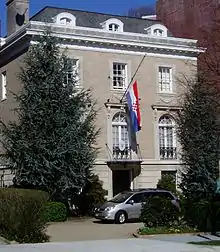
.jpg.webp)
